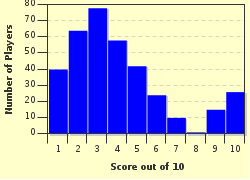Quiz Answer Key and Fun Facts
1. What type of precipitation is associated with a temperature inversion?
2. What is graupel?
3. Where would "ground clutter" most likely be observed?
4. A foehn is which type of weather phenomenon?
5. What volcano was the source of the "Year Without a Summer" in 1816?
6. Which state is not part of Tornado Alley?
7. A line of intense, widespread, and fast-moving thunderstorms is known as a what?
8. What natural disaster occurred on September 8, 1900 in Texas?
9. Where are doldrums located?
10. If I was interested in observing a moonbow where would be a good place to go?
Source: Author
Beuferd
This quiz was reviewed by FunTrivia editor
crisw before going online.
Any errors found in FunTrivia content are routinely corrected through our feedback system.


